American Spirit: 1937 Studebaker J5 Coupe Express
07 May 2020 2 min read 4 images

The Studebaker Brothers Manufacturing Company was founded in 1852 in Indiana and was immediately successful as a wheelbarrow manufacturer for gold rush miners. After producing wagons for the US Army, it entered the automotive market in 1902, with an electric car designed by Thomas Alva Edison. In 1904, under the name ‘Studebaker Automobile Company’, the first car with a combustion engine was produced, praised for its technical qualities and reliability. In the mid-1930s, the Studebaker Dictator Six was introduced, a somewhat unhappy name destined to the replaced by the Commander in 1938, equipped with a 3,600cc L-head type engine with 6 inline cylinders and side valves, capable of producing 90 hp and a very pleasant, art deco line. On the very same platform of the Dictator with similar lines, in 1937, the pickup, called the J5 Coupe Express began production.
Register to unlock this article
Signing up is free and gives you access to hundreds of articles and additional benefits. See what’s included in your free membership. See what's included in your free membership.
Already have an account? Log In


